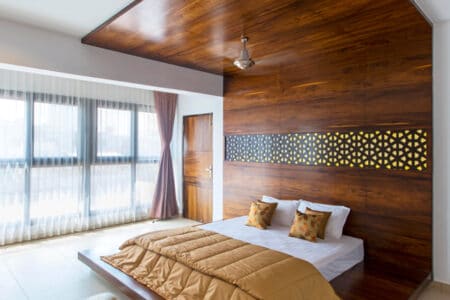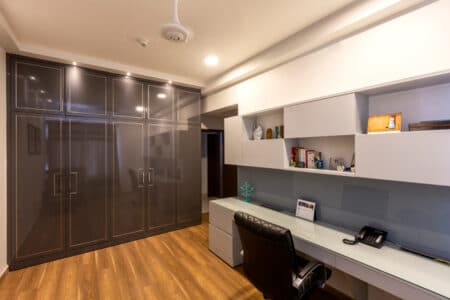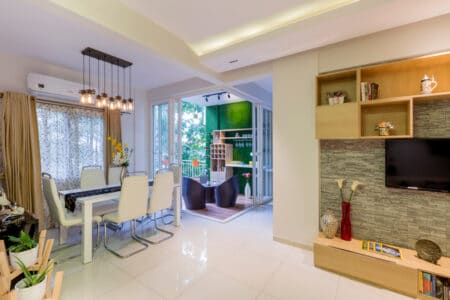Quality Design for All Budgets
Sep 3, 2021

Design Café’s CEO discusses the firm’s unique business traits and considerations for designing personal VT.

Gita Ramanan (GR) is the CEO and co-founder of the home interior solutions firm Design Café (DC). A self-described woman of diverse interests, Ramanan has worn many hats and is driven to excel at all things. During college, she found her calling in architecture and design due to her interests in scientific logic, innovation and creativity. After graduating with a B. Arch from BMS School of Architecture in Bangalore, she worked with well-renowned architects on luxury homes, hospitality and recreational design. Ramanan is also a graduate of ISB, Hyderabad’s entrepreneurial management program, and was selected by Goldman Sachs for its worldwide 10,000 Women Entrepreneur Program.
After more than a decade of working in the residential and hospitality sector, Ramanan decided to focus her energy on filling the existing lacunae in the interior design space with the idea of giving people at all budget levels access to the best designs and manufacturing processes. In 2015, she started Design Café along with Shezaan Bhojani.
Since then, the firm has designed, manufactured and delivered more than 5,000 homes and is the highest-rated company for residential interiors in Bengaluru. The company also successfully launched operations in Mumbai in June 2019. Ramanan shares insights with your author (DM) on what makes the company unique and what aspects should be considered when incorporating vertical transportation (VT) into interior design.
DM: How was DC conceptualized and what specific needs or requirements does it address?
GR: Our journey as entrepreneurs before we launched DC started when Shezaan Bhojani and I participated in (and eventually won) a limited design competition for an 800-apartment complex project shortly after graduating. Subsequently, we went on to design more than 500 projects across the country in areas as diverse as residential, hospitality, retail, commercial and institutional in the next decade. A combination of our comprehensive understanding of the market and products encouraged us to close our existing practice and start DC in 2015 to focus all our efforts to deliver affordable home interiors for Indian homeowners.
The company was set up with the core objective of becoming India’s most trusted brand in the home interior solution space. We have a mission to “democratize great design” and give every Indian homeowner access to million-dollar home design solutions on a budget. We provide complete end-to-end home interior solutions (design to execution and installation) with a hassle-free experience.
DM: Which aspects set DC and its approach to interior design apart?
GR: Our endeavor at DC has always been to benefit the customer by designing a beautiful home at an affordable price. We customize and personalize the design to reflect the taste, whims and fancies of our customers, and as a result, no two DC homes are the same. Our homes are manufactured as per stringent quality control checks laid out by the company and installed by a team of trained specialists.
The three unique selling propositions (USPs) of DC are:
- Provide a hassle-free experience: We are the only vertically integrated home interiors brand in India that has a team of in-house designers who are trained by us. They are not part of the marketplace. If you work with our designers, rest assured they are the best in the business. We are the only online, tech-enabled home interiors brand with its factory where each panel is manufactured on Italian and German machinery to ensure excellence.
- Our installation team is our own: Every single carpenter is trained to deliver the best finish for every product manufactured at our factory.
- We are design-led and customer-focused: We offer personalization and customized solutions. We make all our modular furniture with the best quality materials. Our plywood, for instance, is sourced from the forests of Kerala with inherent anti-termite properties, but we also provide a 10-year warranty to all our customers. What’s more, we provide the best even in the details: The edge binding is German, the hinges are German and the glue comes from Italy. Each cabinet goes through a 51-point quality check (QC) to ensure perfection. We are not a catalog-based company that gives customers modules that are copy-pasted or those that are ready and waiting to be shipped from a warehouse. More than 50,000 SKUs make up our just-in-time custom furniture from over 500 finishes and colors. DC’s designs give you 20% more space per square foot due to our design-thinking approach. We focus on continuous innovation and look to continuously address every customer’s pain points. Our USPs lie in our space-saving designs and innovations.
DM: With the ongoing pandemic and work from home (WFH) being seen as a long-term possibility, to what extent has the importance of home and home office interiors increased? Are aspects like touchless access and creating zones for different activities at myriad times in the same space becoming the norm?
GR: The ongoing pandemic has changed the way each one of us perceives the idea of an ideal home. Working from home and hybrid working models have become the “new normal” globally, and this has structurally changed the way we plan our home interiors and décor. This has put more pressure on industry players like us to deliver homes that give its inhabitants a space to conduct personal and professional interactions.
Apart from utility, customers also demand personalized design solutions, so we make sure the design is part of one’s home and not just machinery.
Most of our customers are young working couples who demand homes that are functional, stylish and durable in all aspects. At DC, we believe great designs have the power to change how you work, play and live. In light of this, we see a few trends that are here to stay:
- The concept and demand for home offices are only increasing. Since we understand this growing need to make WFH a long-term, comfortable experience, we offer efficiently designed, personalized home offices to our customers.
- A few top solutions that are characteristic of our designs are multifunctional corner desks, chic glass-topped designs and custom-made desks/study units to suit the nature of different professions.
- Since the home has become the hub of all our activities, every corner needs to be designed with this in mind, from workstations, entertainment spaces, de-stress zones, fitness corners, meditation nooks and much more.
- Given that everyone is mostly homebound, people have relatively more free time to revisit their hobbies and interests, which has given rise to additional requirements for space. Again, this is something multifunctional, space-saving furniture can quickly solve.
DM: Do you feel that the costs involved for revamped/well-planned home and home office interiors should be considered an investment rather than an expense? What are the direct and indirect benefits that accrue from the process?
GR: A well-planned home office has become the need of the hour, and we see this as a must-have in every home going forward. However, this area, too, needs to be designed, keeping in mind the user’s profession, lifestyle and personal style. So, the short answer to this is “Yes!” Home offices have become, and must be seen as, an investment.
Think of it like this: when you pick out an outfit for a special occasion, you don’t put the entire ensemble together randomly, right? You choose everything from apparel, footwear, jewelry and accessories carefully since you are putting down a sizable amount of money for something you may use just a few times a year. Then why not do the same for your home and home office interiors—something that you will use 365 days of the year?
And more so, every member of your home needs his/her space. Your children need open spaces to play in or a nice activity room to keep busy during post-school hours, while you may look for a well-designed balcony to look over your garden or enjoy an evening cup of tea. Today, home interiors are a big deal, especially in a world where we spend so much time at home, and everyone needs space to do their own thing.
It is important to choose the materials, finishes, hardware and accessories correctly to ensure that the elevator and lobby go with the overall theme and decor of the home.
DM: Why is the blend of experience and expertise important for home and home office interiors? What are the advantages of assigning the task to DC and its team of professionals and, in comparison, the possible pitfalls of trying to manage everything yourself?
GR: The home interior industry has largely been an unorganized sector, and one that is dominated by carpenters and independent contractors. Together, they occupy about 98% of the total market. Now, what’s important to understand here is that the whole process of designing a home’s interiors is complex and involves several moving parts. For example, there’s lighting, carpentry, painting, wallpaper, furniture, fixed furniture, loose furniture and other civil work. Each job function is provided by different vendors. For a client, this can become a hassle to coordinate.
Also, the blue-collar workforce, like carpenters, does not give any quality assurances when it comes to the choice of materials or finishes. Nor is there any adherence to budgets. All this can become extremely frustrating for a client. At DC, we bring all of this together for you. We believe in innovation on the go, and our in-house team has successfully created an AI program that enables the designers to design a custom home for our clients based on their requirements. Designs are personalized and are made in a fraction of the time.
The precision and finesse in these designs are exceptional and eliminate human error. In addition, we have also leveraged virtual reality (VR) to give customers a glimpse of the final design. This gives them a real-time look at what their space will transform into, which helps make decisions faster. Going forward, we want to move to interactive VR that will not only allow the customer to see their finished home before it is built but also allow the designer to change/showcase multiple finishes and colors in real-time to give clients an even more accurate idea of what their personal space will look like.
DM: There is a rising trend of VT, such as elevators or chair lifts, being included at bungalows/row houses, duplexes and penthouses in apartment buildings. Which aspects need to be taken into consideration while incorporating them in terms of sourcing, installation and blending them with the overall look and feel?
GR: Today, customers are looking for comfortable mobility, and this has increased the demand for elevators inside villas and existing structures with ground plus one or more floors. However, apart from utility, customers also demand personalized design solutions, so we make sure the design is part of one’s home and not just machinery. It is important to choose the materials, finishes, hardware and accessories correctly to ensure that the elevator and lobby go with the overall theme and decor of the home.
DM: What are some of the challenges of personalizing spaces, and interiors especially during the pandemic; how does DC resolve them?
GR: COVID-19 and the uncertainty it brought in its wake led many customers to delay their home interior design plans. Some customers with tighter deadlines are under pressure to make up for lost time due to the series of lockdowns. In light of this, we have seen more and more customers wanting to explore and adopt solutions that give them a faster turnaround for their home interior projects. This also means some of them are choosing simpler designs. We also see that customers have become more price-conscious than before and are keen to explore options that are less expensive than they had previously planned. Most importantly, customers are focusing on safety more than before. This has been a boon to players like us that give its customers factory-finished modular furniture. All final units are then assembled on site, and this eliminates the need for labor to work on the project site.





Get more of Elevator World. Sign up for our free e-newsletter.








